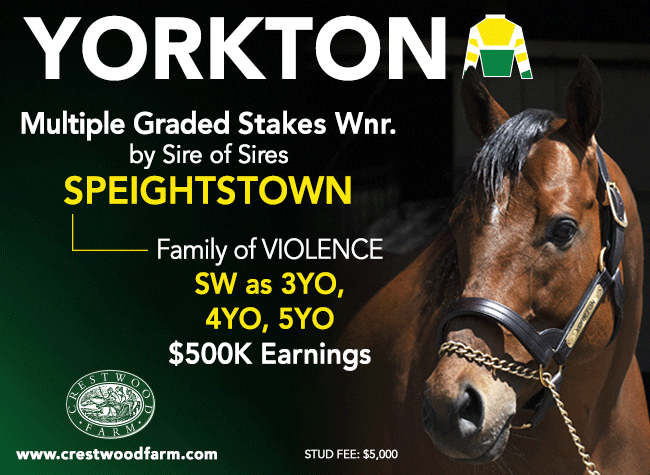By Lucas Marquardt
The striking visual impression of Arrogate's 13 1/2-length win in Saturday's GI Travers S. was confirmed immediately by the time of the race–1:59.36–and has been confirmed again after historically high speed figures were assigned to the track-record performance.
“He looks like a superstar in the making,” said trainer Bob Baffert, who trains Arrogate for Juddmonte Farms (full disclose: author does occasional work for Juddmonte). “I think the fans will remember watching a horse like this, because I know when I see performances like this, it's very rare.”
Baffert isn't exaggerating. Arrogate earned a Beyer Speed Figure of 122, second-best on the season behind the 123 Frosted earned in the GI Met Mile, and the highest Beyer for a race over a mile since Commentator won the 2005 GI Whitney H. with a 123 Beyer.
Since the advent of Beyer Speed Figures, only two other 3-year-olds have earned higher numbers than Arrogate's 122: Sunday Silence and Easy Goer. The pair both earned 124's in their epic GI Breeders' Cup Classic 1-2 in 1989. And only two sophomores, Easy Goer once again, and the great Holy Bull, had matched the 122 figure. The latter did so in his '89 Belmont S. romp, while Holy Bull achieved his career best in the '04 Met Mile.
That puts Arrogate into some exceptionally rare air.
Arrogate earned a similarly impressive number on Jerry Brown's Thoro-Graph figures, a -4 1/2. (On the Thoro-Graph sheets, the lower the number the better, so anything, say, south of a 0 would be considered an exceptionally strong figure.)
How does Arrogate's – 4 1/2 measure up?
“We've been doing this for 30 years, and it's one of the best 3-year-old figures we've ever given out,” said Brown. “And this is the fastest number we've ever given out in the Travers.”
That, according to Brown, is impressive in its own right.
“Historically, it takes a big figure to win the Travers,” he explained. “It's generally the strongest straight 3-year-old race of the year, in terms of figures. You'll get an occasional big figure in the Haskell or in the Jim Dandy. The [Kentucky] Derby and Preakness will occasionally get a big figure, but they're pretty early in the year. But it almost always takes a big figure to win the Travers. Going back 12, 13 years, it typically takes a -2 or so to win the race, which is a big number for a 3-year-old.”
Asked to compare Arrogate's – 4 1/2 to other recent stars of the track, Brown said that last year, for instance, American Pharoah achieved a top figure of – 3 1/2. But Brown quickly added a caveat.
“So it was better than any individual figure that American Pharoah ran,” said Brown. “However, American Pharaoh has 10 figures that are better than Arrogate's second-best figure. American Pharaoh did nothing but run big figures.”
The – 4 1/2, meanwhile, is identical to the number given to California Chrome in his recent GI Pacific Classic tour de force.
“This figure is as good as California Chrome has ever run..and that's pretty damn good,” said Brown.
If Arrogate's speed figures are historically impressive, the raw time of the Travers–1:59.36–is just as noteworthy.
It isn't just that the time shattered General Assembly's 37-year-old 1 1/4-mile track record at Saratoga of 2:00.00. It's that THAT mark was a towering figure at Saratoga. Consider this: in the 147-year history of the Travers, only four horses had shaded 2:01 flat, let along 2:00 flat. Honest Pleasure did so in 1976, followed by General Assembly, Easy Goer ('89), and Thunder Rumble ('92).
“The track on Travers Day was pretty fast, and part of his time was reflective of the track being fast, but it was still very, very fast,” said Brown.
Interestingly, while Frosted and Arrogate ran very similar numbers on the Beyer scale–123 vs. 122, respectively–the former earned a much stronger number on the Thoro-Graph sheets, a massive – 8 1/2 that established a new high-water mark at Thoro-Graph.
“Beyer figures don't reflect ground loss, and since Arrogate saved ground, his number is slightly inflated,” said Brown. “The fact that he saved ground and Frosted came around [horses], that's one of the reasons their numbers are similar on Beyer but not on ours. But again, but it's still a very big figure.”
To illustrate his point on ground loss, the 2012 Travers was a dead heat between Alpha and Golden Ticket, but the two respective speed figures the two received were two points different due to the fact that Golden Ticket saved ground.
Adherents to the Thoro-Graph sheets typically look for horses to bounce off big efforts, particularly if a horse is making a substantial jump on the sheets. Like Arrogate did in the Travers.
“Baffert's talking about not running until the Breeders' Cup Classic, and I think that's right,” Brown opined. “This figure has nothing to do with what this horse did before in his previous races, and who knows how he'll react to it. But there's a difference between Baffert and everyone else…and I mean this. Baffert's able to hold horses together for a series of big races in a way that no one else can. Nobody–top trainer, bad trainer, nobody–can get horses to run a big number just after running another big number like Baffert can. This is the test now with this one.”
Brown admitted that he was one of a great many who was surprised by Arrogate's effort in the Travers.
“Baffert was texting me before the race and said that this horse was better than [Travers runner-up] American Freedom, and I told him I didn't believe him,” Brown said. “I said, 'Let him show it to me.'”
So what happened?
“After the race, Baffert texted, 'Do you believe me now?'”
Suffice it to say, we all do now.
Not a subscriber? Click here to sign up for the daily PDF or alerts.






